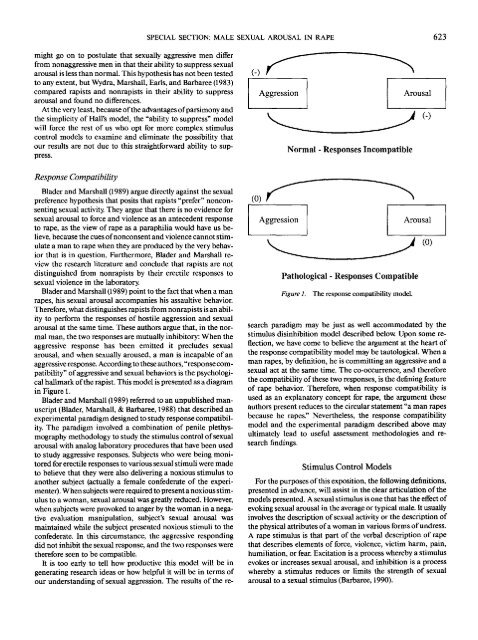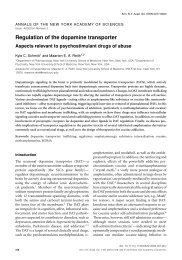The Role of Male Sexual Arousal in Rape: Six Models
The Role of Male Sexual Arousal in Rape: Six Models
The Role of Male Sexual Arousal in Rape: Six Models
Create successful ePaper yourself
Turn your PDF publications into a flip-book with our unique Google optimized e-Paper software.
might go on to postulate that sexually aggressive men differ<br />
from nonaggressive men <strong>in</strong> that their ability to suppress sexual<br />
arousal is less than normal. This hypothesis has not been tested<br />
to any extent, but Wydra, Marshall, Earls, and Barbaree (1983)<br />
compared rapists and nonrapists <strong>in</strong> their ability to suppress<br />
arousal and found no differences.<br />
At the very least, because <strong>of</strong> the advantages <strong>of</strong> parsimony and<br />
the simplicity <strong>of</strong> Hall's model, the "ability to suppress" model<br />
will force the rest <strong>of</strong> us who opt for more complex stimulus<br />
control models to exam<strong>in</strong>e and elim<strong>in</strong>ate the possibility that<br />
our results are not due to this straightforward ability to sup-<br />
press.<br />
Response Compatibifity<br />
Blader and Marshall (1989) argue directly aga<strong>in</strong>st the sexual<br />
preference hypothesis that posits that rapists "prefer" noncon-<br />
sent<strong>in</strong>g sexual activity. <strong>The</strong>y argue that there is no evidence for<br />
sexual arousal to force and violence as an antecedent response<br />
to rape, as the view <strong>of</strong> rape as a paraphilia would have us be-<br />
lieve, because the cues <strong>of</strong>nonconsent and violence cannot stim-<br />
ulate a man to rape when they are produced by the very behav-<br />
ior that is <strong>in</strong> question. Furthermore, Blader and Marshall re-<br />
view the research literature and conclude that rapists are not<br />
dist<strong>in</strong>guished from nonrapists by their erectile responses to<br />
sexual violence <strong>in</strong> the laboratory.<br />
Blader and Marshall (1989) po<strong>in</strong>t to the fact that when a man<br />
rapes, his sexual arousal accompanies his assaultive behavior.<br />
<strong>The</strong>refore, what dist<strong>in</strong>guishes rapists from nonrapists is an abil-<br />
ity to perform the responses <strong>of</strong> hostile aggression and sexual<br />
arousal at the same time. <strong>The</strong>se authors argue that, <strong>in</strong> the nor-<br />
mal man, the two responses are mutually <strong>in</strong>hibitory: When the<br />
aggressive response has been emitted it precludes sexual<br />
arousal, and when sexually aroused, a man is <strong>in</strong>capable <strong>of</strong> an<br />
aggressive response. Accord<strong>in</strong>g to these authors, "response com-<br />
patibility" <strong>of</strong> aggressive and sexual behaviors is the psychologi-<br />
cal hallmark <strong>of</strong> the rapist. This model is presented as a diagram<br />
<strong>in</strong> Figure 1.<br />
Blader and Marshall (1989) referred to an unpublished man-<br />
uscript (Blader, Marshall, & Barbaree, 1988) that described an<br />
experimental paradigm designed to study response compatibil-<br />
ity. <strong>The</strong> paradigm <strong>in</strong>volved a comb<strong>in</strong>ation <strong>of</strong> penile plethys-<br />
mography methodology to study the stimulus control <strong>of</strong> sexual<br />
arousal with analog laboratory procedures that have been used<br />
to study aggressive responses. Subjects who were be<strong>in</strong>g moni-<br />
tored for erectile responses to various sexual stimuli were made<br />
to believe that they were also deliver<strong>in</strong>g a noxious stimulus to<br />
another subject (actually a female confederate <strong>of</strong> the experi-<br />
menter). When subjects were required to present a noxious stim-<br />
ulus to a woman, sexual arousal was greatly reduced. However,<br />
when subjects were provoked to anger by the woman <strong>in</strong> a nega-<br />
tive evaluation manipulation, subject's sexual arousal was<br />
ma<strong>in</strong>ta<strong>in</strong>ed while the subject presented noxious stimuli to the<br />
confederate. In this circumstance, the aggressive respond<strong>in</strong>g<br />
did not <strong>in</strong>hibit the sexual response, and the two responses were<br />
therefore seen to be compatible.<br />
It is too early to tell how productive this model will be <strong>in</strong><br />
generat<strong>in</strong>g research ideas or how helpful it will be <strong>in</strong> terms <strong>of</strong><br />
our understand<strong>in</strong>g <strong>of</strong> sexual aggression. <strong>The</strong> results <strong>of</strong> the re-<br />
SPECIAL SECTION: MALE SEXUAL AROUSAL IN RAPE 623<br />
S<br />
Aggression I <strong>Arousal</strong><br />
j (')<br />
S<br />
Normal - Responses Incompatible<br />
Aggression <strong>Arousal</strong><br />
j (0)<br />
Pathological - Responses Compatible<br />
Figure 1. <strong>The</strong> response compatibility model.<br />
search paradigm may be just as well accommodated by the<br />
stimulus dis<strong>in</strong>hibition model described below. Upon some re-<br />
flection, we have come to believe the argument at the heart <strong>of</strong><br />
the response compatibility model may be tautological. When a<br />
man rapes, by def<strong>in</strong>ition, he is committ<strong>in</strong>g an aggressive and a<br />
sexual act at the same time. <strong>The</strong> co-occurrence, and therefore<br />
the compatibility <strong>of</strong> these two responses, is the def<strong>in</strong><strong>in</strong>g feature<br />
<strong>of</strong> rape behavior. <strong>The</strong>refore, when response compatibility is<br />
used as an explanatory concept for rape, the argument these<br />
authors present reduces to the circular statement "a man rapes<br />
because he rapes:' Nevertheless, the response compatibility<br />
model and the experimental paradigm described above may<br />
ultimately lead to useful assessment methodologies and re-<br />
search f<strong>in</strong>d<strong>in</strong>gs.<br />
Stimulus Control <strong>Models</strong><br />
For the purposes <strong>of</strong> this exposition, the follow<strong>in</strong>g def<strong>in</strong>itions,<br />
presented <strong>in</strong> advance, will assist <strong>in</strong> the clear articulation <strong>of</strong> the<br />
models presented. A sexual stimulus is one that has the effect <strong>of</strong><br />
evok<strong>in</strong>g sexual arousal <strong>in</strong> the average or typical male. It usually<br />
<strong>in</strong>volves the description <strong>of</strong> sexual activity or the description <strong>of</strong><br />
the physical attributes <strong>of</strong> a woman <strong>in</strong> various forms <strong>of</strong> undress.<br />
A rape stimulus is that part <strong>of</strong> the verbal description <strong>of</strong> rape<br />
that describes elements <strong>of</strong> force, violence, victim harm, pa<strong>in</strong>,<br />
humiliation, or fear. Excitation is a process whereby a stimulus<br />
evokes or <strong>in</strong>creases sexual arousal, and <strong>in</strong>hibition is a process<br />
whereby a stimulus reduces or limits the strength <strong>of</strong> sexual<br />
arousal to a sexual stimulus (Barbaree, 1990).










